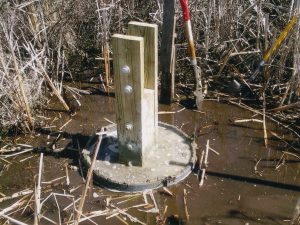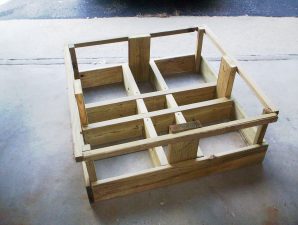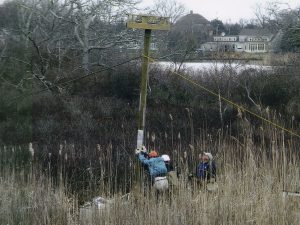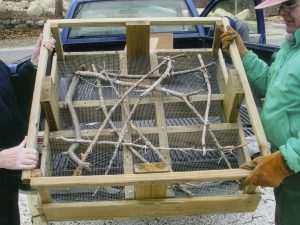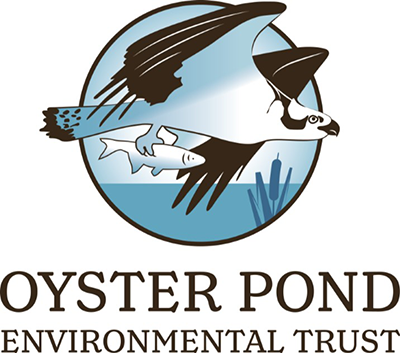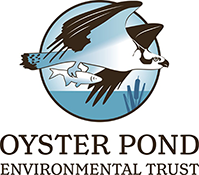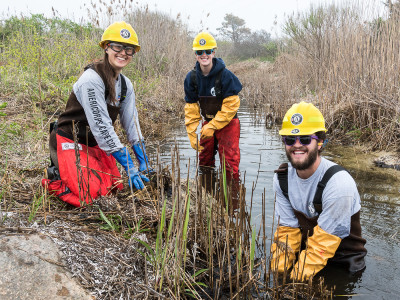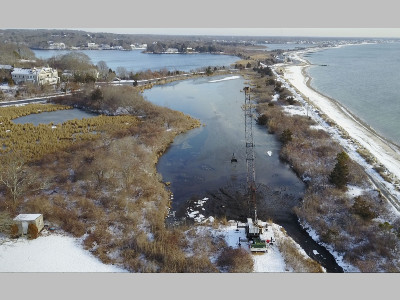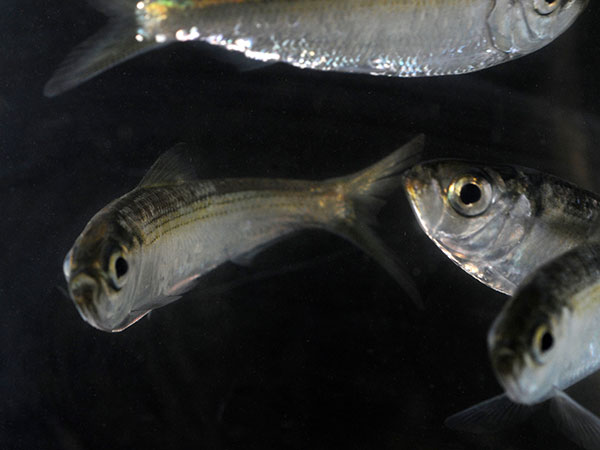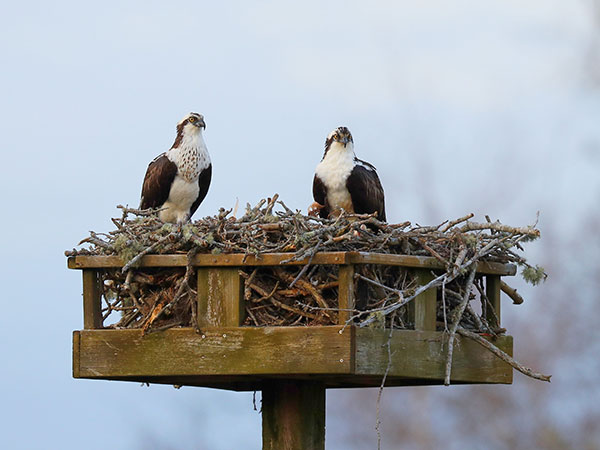About OPET
What We Do
OPET was formed in 1994 to conserve and protect the water quality, environment, ecological systems and natural beauty of Oyster Pond.
We oversee all aspects of the pond and the surrounding watershed lands that impact the pond’s water quality. Our projects include improvements and maintenance to our 30 acres of conservation lands of woodlands, vernal pools and wetlands. We also monitor the Town of Falmouth’s plans for removing the excess nitrogen from septic systems impacting the pond’s water quality. For many years, OPET has worked to restore native habitat and scenic vistas of the pond from the bike path by removing exotic, invasive plants. One of our biggest challenges to maintaining the water quality of the pond is keeping the outlet of the pond open to the ocean. This helps maintain the salinity of the water at the desired levels and to prevent a repeat of the 2016 algal bloom. We also enjoy observing the animals that live, shelter and raise their young in the surrounding area. Watch our videos from wildlife cameras installed at key spots around the pond and on our land. We also monitor the population of herring that spawn in Oyster Pond. In 2007, we put up an osprey nest platform, one of the first in the area, to encourage their return to the area after the plummeting population numbers from DDT. Happily, many, many osprey young have now been raised here!
Invasive Plants Removal Project
Since 2006, OPET has worked to restore and preserve the critical shoreline habitat on Oyster Pond and its outlet through the Lagoon and Trunk River by removing exotic invasive plants. Shorelines support a diversity of life as the link between water and uplands.
Pretty to look at and colorful to see, but exotic invasive plants bullied their way into Oyster Pond’s ecosystem. Removing exotic invasive plants from the Oyster Pond watershed is one of our priority projects. OPET has concentrated our efforts in three areas – removing bush honeysuckle and privet from our conservation land in Zinn Park, eradicating purple loosestrife, and removing Phragmites australis from the southern shoreline of Oyster Pond and Trunk River.
“Exotic” invasive plants are plants introduced from other parts of the world. Lacking their native, natural controls, they can spread rapidly in new ecosystems and thrive in a variety of environments. Many are garden escapees that develop self-sustaining populations that dominate or disrupt natural ecosystems. Not all introduced or exotic plants are invasive. It is the aggressiveness, adaptability and difficulty in eradicating these plants that labels them as an invasive species.
Nearly 98% of the phragmites has been removed from the treated shoreline areas. Native vegetation long suppressed under the phragmites is rebounding. This preserves habitats for birds, fish and animals that depend on native plants for nest materials, food sources and shelter.
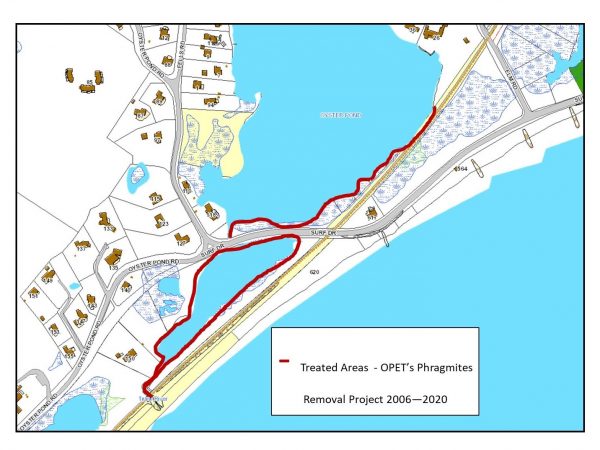
Many Thanks!
OPET is very grateful to the Woods Hole Foundation, the Salt Ponds Area Bird Sanctuaries, the Moors Association, Woods Hole Oceanographic Institution and especially the People of Falmouth through the Community Preservation Fund for funding this project. Thanks also to the many volunteers and especially to the Americorps Cape Cod. We literally could not have done it without their help!
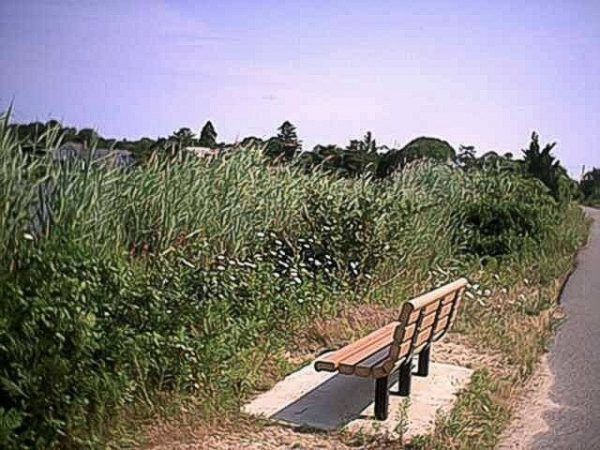
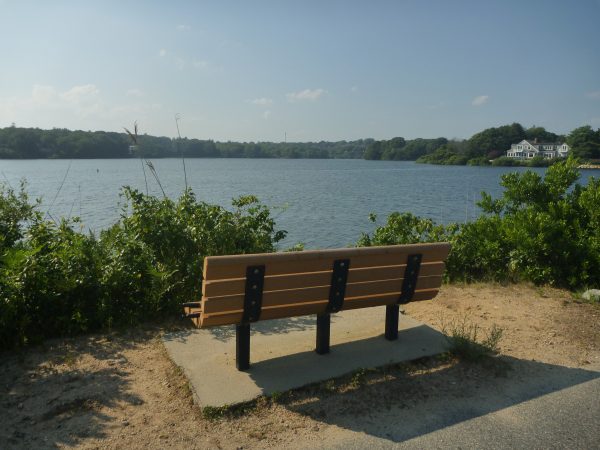
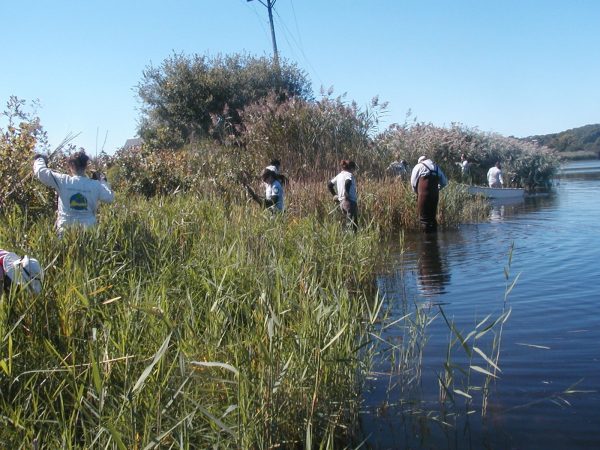
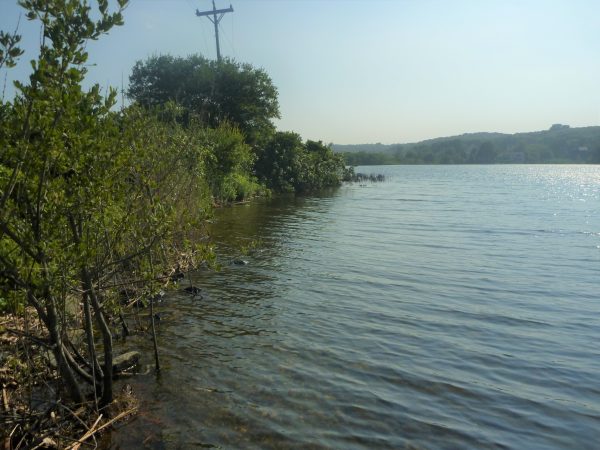
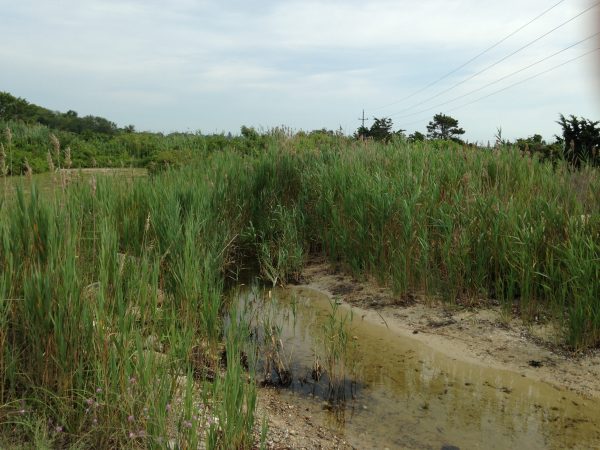
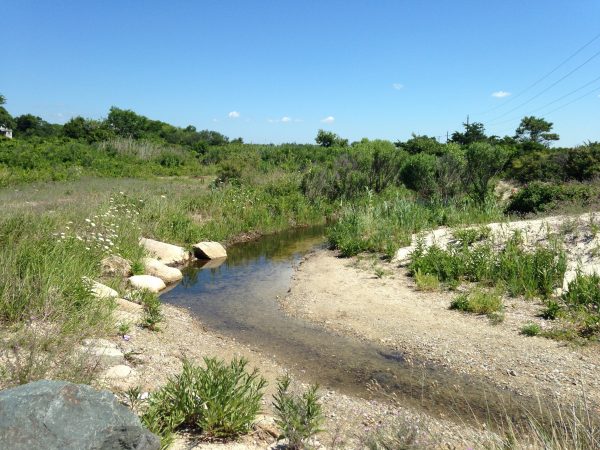
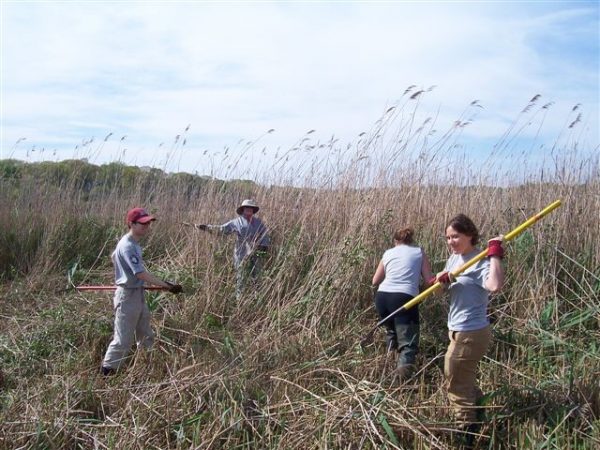
Tackling phragmites with the help of Americorps in 2009.
What’s Wrong with Phragmites?
Phragmites australis, or common reed, is a large perennial grass found in wetlands around the world. In its native habitat in Europe and Asia it is an important plant used for everything from thatched roofs to baskets. In North America it lacks its native, natural controls to keep it in check. Here, It forms dense monocultures of almost impenetrable stands that can grow 15 feet high and spread by rhizome runners that can grow 10 feet in one year. A few plants can quickly overwhelm a wetland site, choking out native plants, changing water hydrology and altering wildlife habitat.
Phragmites is very difficult to eradicate. A section of the root system remains dormant until the plant is cut and then it springs into action, quickly rebounding and growing. Each node on the canes can also root and grow into a new plant. That is why repeated annual treatments are required until the plant can be completely eliminated.
There are stands of native phragmites in the Great Sippewissett Marsh in West Falmouth. Unlike its introduced cousin, this variety peacefully coexists with our native Cape Cod wetland plants. You can see of some of this type of Phragmites at the 6.2-mile marker from the Shining Sea bike path in West Falmouth.
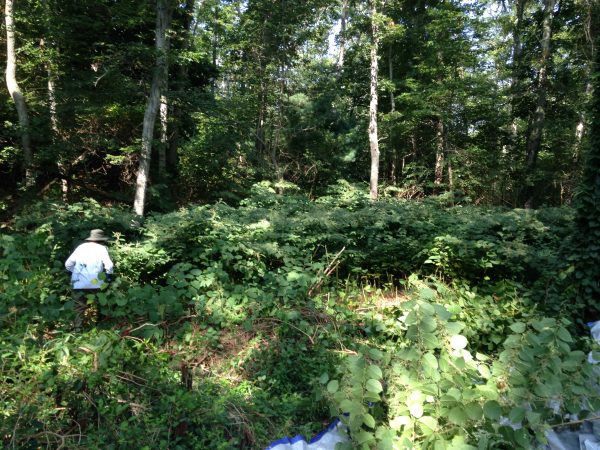
A knotweed patch at the end of Fells Road that we have been battling for several years now.
Japanese Knotweed
one of the Worst in the World
Japanese knotweed makes phragmites look tame by comparison. It is listed as one of the world’s 100 worst invasive species by the World Conservation Union. In the United Kingdom, where it is very problematic, it can only be disposed of as a “controlled waste”. While phragmites favor growing in wet areas, Japanese knotweed grows everywhere – wet, dry, shady, or sunny conditions. It spreads by both rhizome and seed dispersion while a piece as small as a fingernail can sprout into a new plant.
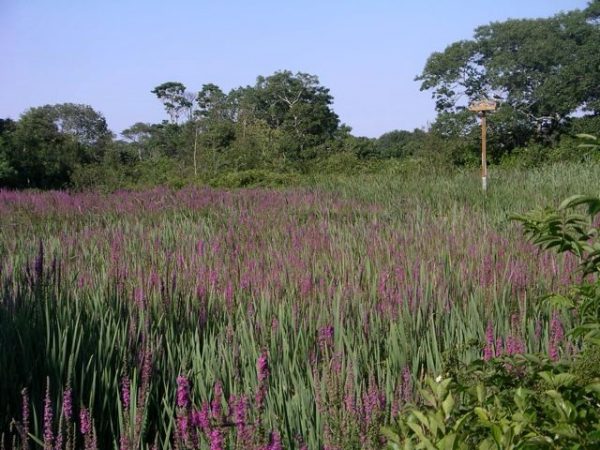
The wetland area near the OPET osprey nest platform in 2007 when is was overwhelmed with purple loosestrife.
The Purple Marsh Monster
Purple loosestrife was once a popular garden plant due to its adaptability. It escaped into the wild, quickly spreading into wetland areas. An estimated 475,000 acres of wetlands are degraded annually in North America by this “purple plague.” It is a hardy perennial that can reach 8 feet in height with a single plant producing up to 300,000 seeds annually. These seeds can be widely dispersed and remain viable in the ground for years.
OPET coordinated treating loosestrife around the pond with the Falmouth Wetlands Invasives Steering Committee (WISC), a town committee that spearheaded efforts to control both phragmites and purple loosestrife. WISC chose biological controls –loosestrife eating beetles – since neither mowing, burning, herbicide treatments nor water level management would be successful. The USDA rigorously tested the beetles for potential impacts prior to approving their use in 1992. The studies demonstrated these beetles are “host specific” to loosestrife species, meaning they only lay their eggs on loosestrife and their larvae feed exclusively on loosestrife.
In June 2006, WISC released two species of host specific loosestrife eating beetles, Galerucella calmariensis and Galerucella pusilla in the Oyster Pond area. Fifteen hundred beetles were released in the Trunk River marsh area and 500 beetles in the small marsh across the bike path from the southern shore of Oyster Pond. Since then the beetles are successfully kept the loosestrife in check. Plants can still be seen, but not in the numbers of previous years.
Trunk River Project
Keeping the Pond Open to the Sea
One of OPET’s biggest management issues is keeping the exchange between the pond and the ocean open. This is key to maintaining the ecological health of Oyster Pond. It is of utmost importance for keeping the salinity in the pond between the targeted levels of 2 parts per thousand (ppt) and 4 ppt. If the salt level is too low we risk a repeat of the terrible pea-green soup algal bloom of the summer of 2016. If the salinity is too high, however, it decreases oxygen at the bottom of the pond, which is detrimental to our herring population and other aquatic creatures. We keep a close eye on the salt levels and measure it every month (see page x for more info)
Storms are a constant challenge as they bring in fine sands and dead eel grass that clog the system. The body of water we affectionately call “The Lagoon” is the intermediary between Oyster Pond and Trunk River. The connection between these three water bodies is a delicate balancing act that requires constant monitoring. It is also important to keep this open for the pond’s resident herring population and to avoid flooding neighborhood basements. This report on the Trunk River Problem and the Weir Report from 2004 explains how blockage of any of these components can cause problems.
Currently, Trunk River is Oyster Pond’s only outlet to the sea. Historically, the number and location of Oyster Pond’s connections to Vineyard Sound have changed and fluctuated over time, depending on the ferocity of winter nor’easters and hurricanes. Geologic evidence shows at one time there were up to three outlets. One of the reasons oysters disappeared from Oyster Pond is likely due to dropping salinity levels when storms closed the exchange with the ocean and the pond water became too fresh. Once the railroad to Woods Hole was completed in 1872, the outlet of Oyster Pond was fixed to Trunk River.
In 1990, the culvert through which Oyster Pond drains into the Lagoon collapsed. It was replaced by a larger culvert, which unfortunately allowed much more salt water into the pond than before. Salinity levels skyrocketed from 3 to 5 ppt to 20 to 30 ppt. This caused a rapid change in the habitat of the pond – yellow and white perch populations crashed and barnacles started growing on the Treetops dock. The pond waters stratified with the heavier salt water sinking to the bottom of the pond while the fresh water from precipitation and groundwater floated on top. This stratification also caused anoxic conditions at pond bottom as it limited the interchange of oxygen between the two layers. The influx of salt water also stimulated the saltwater algae to grow and caused the fresh water vegetation to die, further exacerbating the severe benthic oxygen depletion. New plant growth in the pond exploded, now thriving on nitrogen-limited conditions. It was so high that it was difficult to swim or even boat on the pond.
In 1989 a weir was installed just north at the culvert on Surf Drive to limit the inflow of salt water to only the highest tides. The drop in salinity dampened the impacts of high nitrogen. This is because saline waters are sensitive to nitrogen. Salt waters are said to be nitrogen limited — meaning that the amount of nitrogen can limit or increase impacts to a water body’s habitat. In contrast, fresh waters are phosphorus limited.
Unfortunately, other components in the system overwhelm the weir from working properly as can be seen in the profile below.

This elevation profile of the Oyster Pond system from 1996 demonstrates how a buildup in the Trunk River or the lagoon can impede flow out of Oyster Pond.
With the weir control, the salinity can be temporarily increased to reduce freshwater type growths of aquatic weeds and algae. If nitrogen-limited plants begin to increase to too much density, the salinity can be lowered.
In 2004 a combination of low rainfall and blockage in Trunk River caused an unsightly (and unhealthy to migrating herring) mat of Cladaphora glomerata to spread across the surface of the lagoon.
OPET is thankful to the Town of Falmouth for working with us to keep the system open by dredging Trunk River and the Lagoon when it is clogged. Over the years, the Town has dredged Trunk River when it is nearly filled to the top with sand after fierce nor’easters. The most dramatic clean out was in Feb 2017 when 750 yards of decaying eel grass and muck were removed from the Lagoon. Realizing the importance of keeping this flow open, the Town has included a dredging schedule for Trunk River and the Lagoon as part of their wastewater management plan for Oyster Pond.
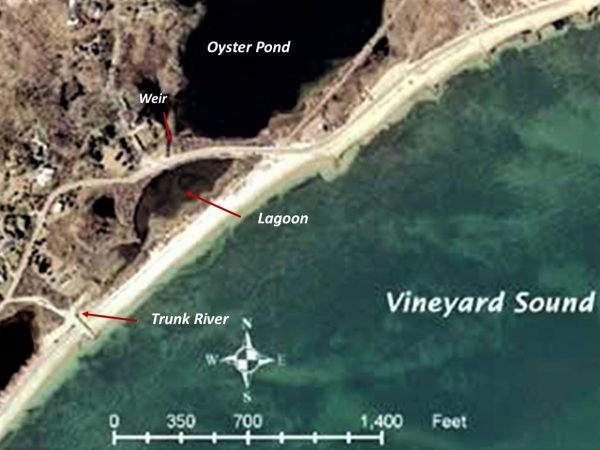
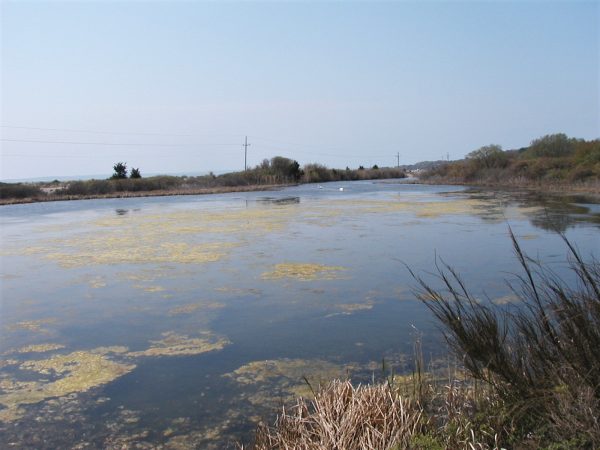
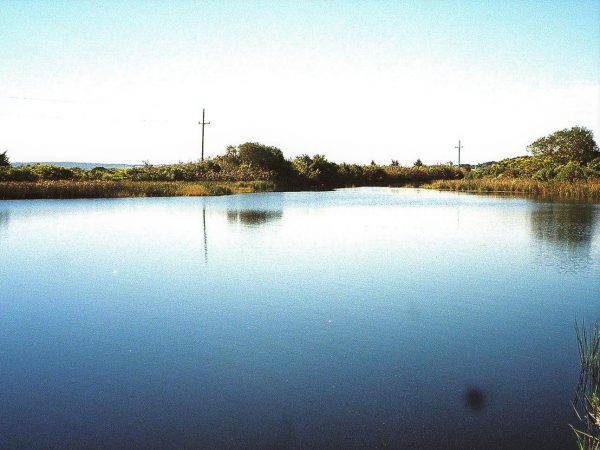
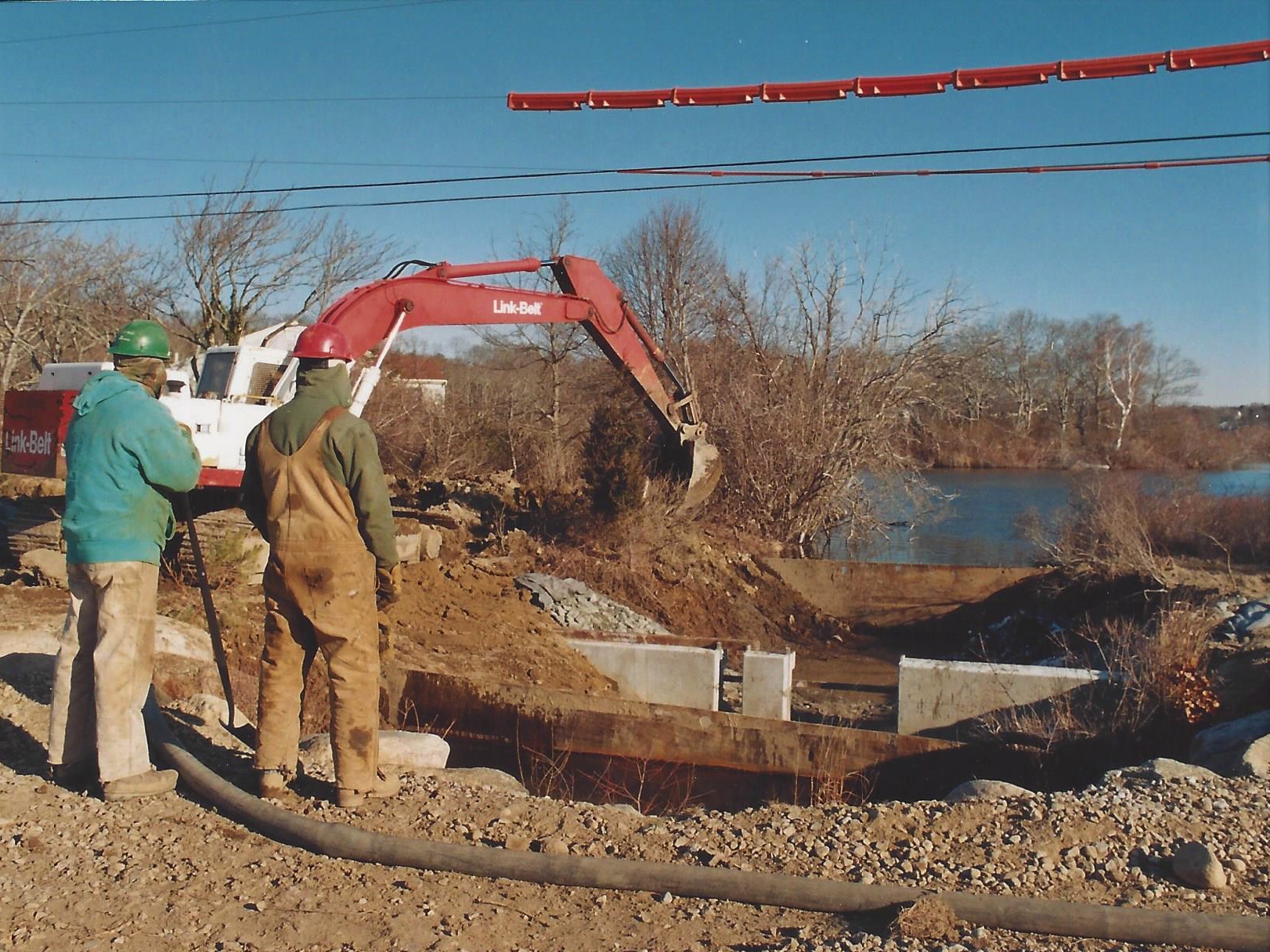
Construction of the weir in March 1998.
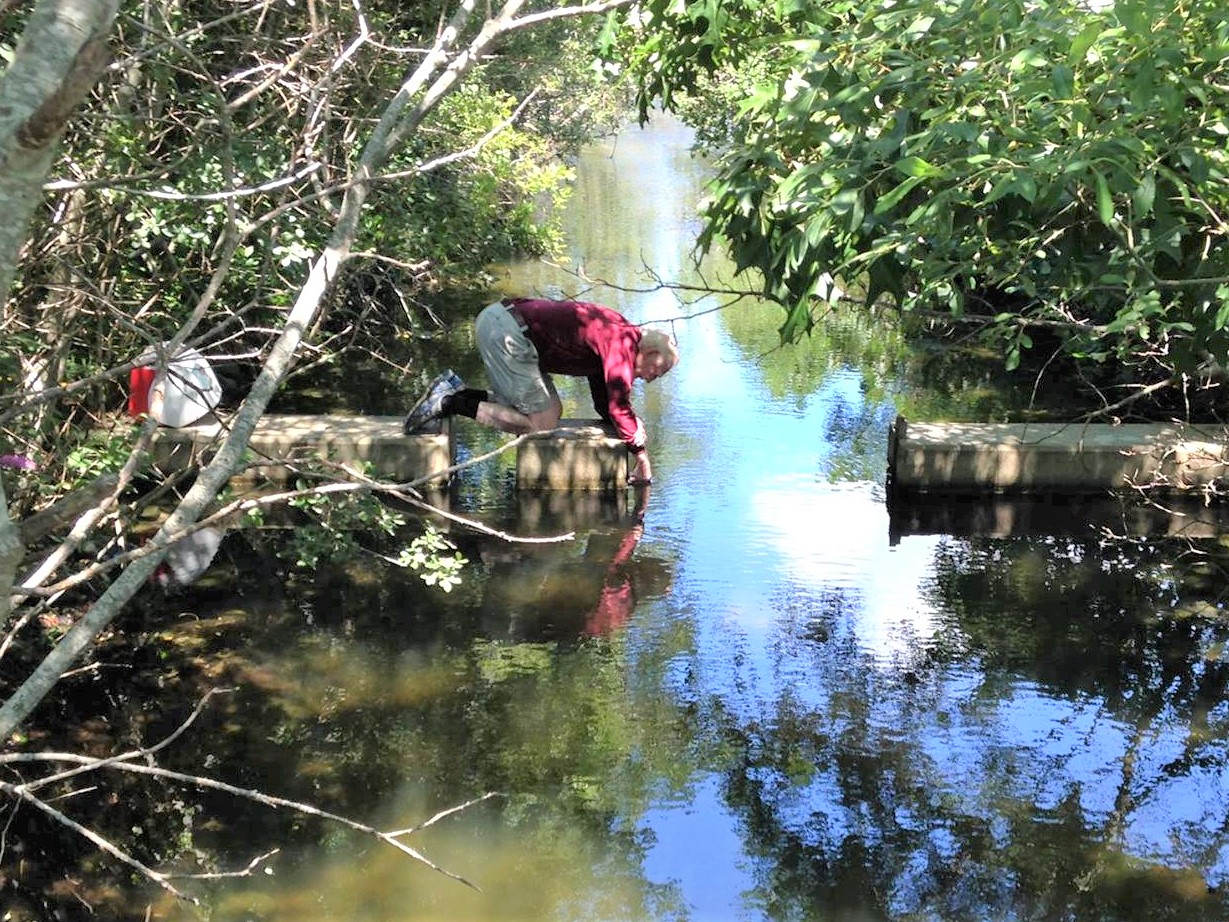
Past OPET President Lou Turner measuring the height of the water at the weir in 2016.
Monitoring Herring and other Fisheries
Oyster Pond is home to several important fish species including alewife herring (Alosa pseudoharengus), American eels (Anguilla rostrata), white perch (Morone americana) and at one time, yellow perch (Perca flavescens). It was the dramatic decline of white and yellow perch in the mid-1980s that signaled to the residents of the Oyster Pond that something was amiss about the pond and spurred the formation of OPET.
River herring played an important role in the history and coastal heritage of Cape Cod. They are a keystone species in a coastal ecosystem as food source for other fish and other animals (see the wildlife videos of the variety of animals that show up at the weir to catch herring during the spring run).
Oyster Pond is the third largest herring run in Falmouth. OPET plays a crucial role in ensuring this run remains viable. The Town of Falmouth Herring Warden, Chuck Martinsen, relies on OPET to maintain safe passage for the adult herring during the annual spring migration. We monitor Trunk River daily during the spring migration season since high tides and spring storms can create sand plugs that block the river channel.
Many long-term residents of Cape Cod tell stories about herring runs so large and so dense that they were “a fire hose of fish”– you could scoop as much as you wanted and they still kept coming. Unfortunately, those days are long gone. Herring populations declined precipitously along the Atlantic seaboard in the 2000s. Some herring run numbers dropped by 90%, prompting the Massachusetts Marine Fisheries Advisory Commission to put a moratorium on the harvest, possession and sale of river herring in 2006 that continues to this day. This prompted OPET to take a closer look at our own herring population and realize what an important role preserving and improving this population can play for the species as a whole. Since 2009, Lou Turner has organized volunteers to count the incoming herring for about an hour in the evening once a week. Volunteers start at dusk as the herring like to move under the cover of darkness. Though these numbers are not robust statistically, since herring that move later in the night are missed, they do give us a snap shot.
Herring are an anadromous fish, meaning they spawn in fresh water and then spend the rest of their adult life in the ocean. They return three to four years later to spawn in their natal, fresh water pond. They can live up to eight years and will continue to return each spring to spawn. Alewives begin returning in mid-March, depending on the weather. The fish usually wait until the water temperature is about 50 degrees F before they start their “run” that lasts from 6 to 8 weeks.
After spawning, the adults return to the sea over a period of several weeks. Their young exit the pond beginning in June and continue until December. The fry often school at the Oyster Pond weir for several days before they exit. It is a sight to see this massive ball of young herring waiting for a signal to begin their journey to the sea, known only to them. Usually a large rain storm will prompt them to leave.
American Eels – Oyster Pond’s Other Important Resident
Much of the focus for the pond’s wildlife has centered on alewife herring, but there is another resident that makes Oyster Pond its home that is just as important – the American eel. Unfortunately like the herring, eel populations are dropping. Dams and other river obstructions, hydropower plants and overfishing are contributing to their population drop. Fortunately, Oyster Pond is home to a very healthy eel population.
Less is known about our eel population due to their more elusive live style. One herring counter did see hundreds of tiny eels, known as glass eels, migrate into Oyster Pond a few years ago.
Eels have an opposite life cycle from herring. While adult herring are entering Trunk River to migrate up to Oyster Pond in the spring to spawn, young eels or elvers are entering the pond to grow into adults. They were hatched in the far-off Sargasso Sea, an area of becalmed ocean between Bermuda and the Bahamas in the middle of the Atlantic. Unlike herring, elvers do not migrate back to a particular estuary or river. Rather, millions of small eels a few inches long drift along ocean currents migrating to where luck will take them to any fresh or marine waters.
They can spend up to 30 years in the juvenile yellow eel stage eating fish, crustaceans, insects, worms and frogs. In turn eels are meals for striped bass and other fish, gulls, ospreys and other fish-eating birds. When they reach adulthood they turn silver for the long migration back to the Sargasso Sea.
White Perch Fish stories from 2007
In the late 1980s the white perch disappeared – the pond essentially crashed because of the influx of salt water that was coming into the pond via the much larger new culvert the town installed. The salt water sank to the bottom and the fresh water from the north end of the pond remained on top; hence the bottom became anoxic – there was insufficient oxygen to support fish. When it was realized what was going on, the weir was installed at the entrance of the pond to keep the pond sufficiently fresh and increase oxygen at the bottom. The fish returned and today the pond is as healthy as far as white perch are concerned as it was in the early 80s.
Unfortunately, yellow perch have not fared as well. Few if any yellow perch have been seen in recent years.
Lou Turner helped John Dowling catch white perch for John’s annual research on the health of the white perch population in the Pond. For a number of years John used white perch from Oyster Pond for research on retinal neurons at Harvard University.
In one hour in 2007, they caught about 40 white perch. The smallest was about 5 inches and largest about 11 inches. They all looked very healthy. They were all returned. John used worms and Lou a small white lure with a spinner. Being the fisherman that he is, Lou reports that the fish did not prefer one type of bait over the other.
The splashing in the background is from white perch lurking in the culvert and darting out to catch a herring snack. The herring fry can be seen congregating at the weir waiting for the cover of darkness to migrate to Vineyard Sound from about late June to early December, depending on the weather. During the hot, dry summer months they are rarely seen, except after heavy rainstorms. Their appearance is more frequent in the fall. Rain nearly always brings an influx of herring to the weir. Rain or a rush of water triggers the migration response in the young herring. This is the only location that we are aware of where the population of herring fry can be estimated.
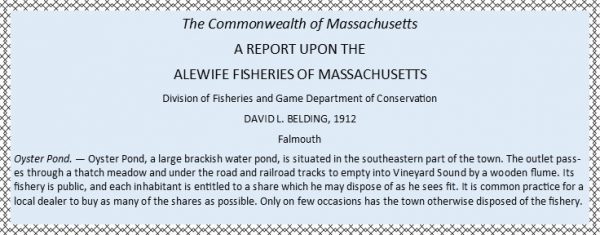
An interesting description of Oyster Pond from over 100 years.
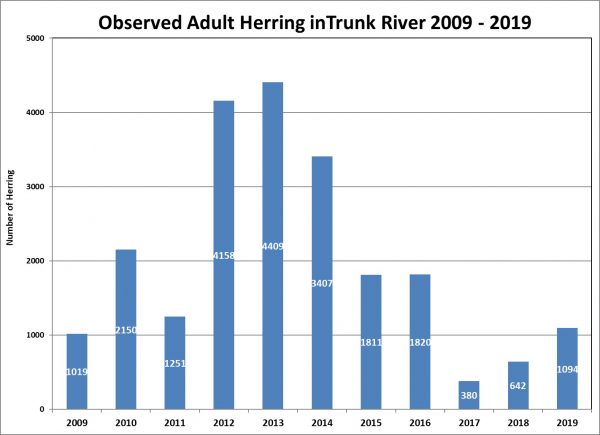
These are the observed number of herring seen by volunteers during the first hour after dusk during the six week spring migration. Many more could have moved up to the pond later in the night. Scientists are trying to understand why the drop in herring populations occurred. It is likely a combination of fishing by-catch impacts as ocean and river herring can mingle together in the ocean, obstructions in the migratory streams, and loss of spawning habitat.
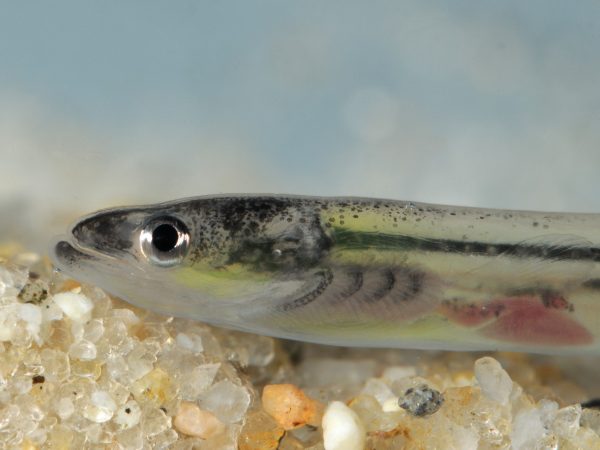
A glass elver at Oyster Pond.
Photo by Dann Blackwood of USGS
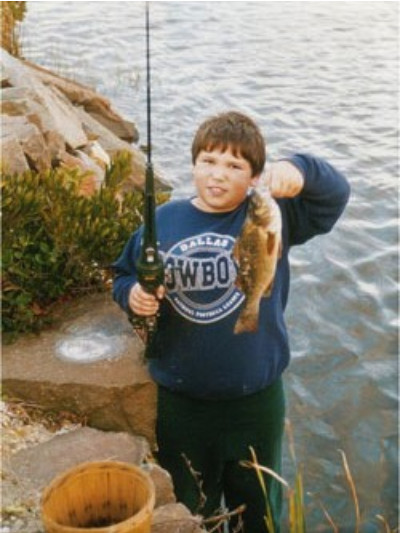
Peter Ray, a young fisherman with his white perch caught at the Oyster Pond culvert in 1997.
Osprey Nest Platform
OPET raised an osprey nest platform in April 2007. For many years OPET searched for a suitable location, one that is accessible for building the platform, yet far enough away from trees that can harbor Great Horned Owls, the osprey’s only predator. OPET settled on the Town-owned conservation land at the southwest corner of Oyster Pond as the best spot, as not only is it away from trees, but the wet marsh prevents raccoons from climbing the pole. The pole can also be seen by the public from Oyster Pond Road.
After receiving permission from the Conservation Commission, OPET designed, constructed, and put up the osprey platform. The nest platform was designed and constructed by Barry Norris, while Bill Kerfoot designed the base, pole, and the method for raising the platform. The challenge was to design a base to be stable in 6 feet of peat and be able to be lowered for periodic cleaning.
The base for the pole was constructed first. The base consists of a two-tined fork embedded in a cylinder of concrete 3 feet wide and 3 feet deep. The nest platform was added to a 16 foot long pole and raised into position. A pivot at the base of the pole allowed it to be pulled into an upright position by ropes. A bar at the base stopped the pole when it reached a vertical position. Once the pole was vertical, additional bolts were added above and below the pivot to prevent the pole from rotating. The last step was to add braces to stabilize the pole for the long run. It took a few years for the ospreys to move in, but for several years now a pair of osprey have successfully raised chicks each summer.
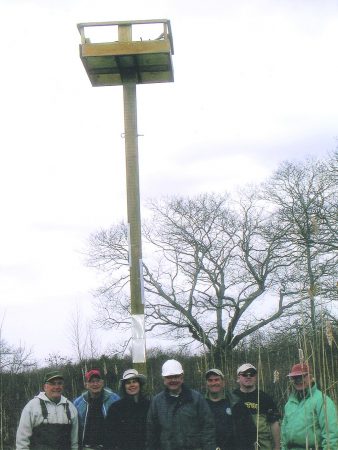
Osprey Platform Team
